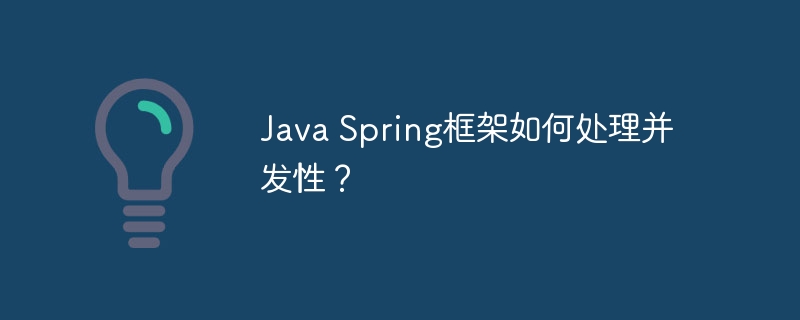How does the Java Spring framework handle concurrency?
The Spring framework manages concurrency through two mechanisms: thread pool and asynchronous processing: Thread pool: Use the ThreadPoolTaskExecutor class to configure the core and maximum number of threads and queue capacity. Asynchronous processing: Use the @Async annotation to mark methods so that they can be executed asynchronously in a separate thread without the need to manually manage threads.

How the Java Spring Framework handles concurrency
The Spring framework provides a variety of mechanisms to manage concurrency, including thread pools and Asynchronous processing.
Thread Pool
Spring provides thread pool functionality through the ThreadPoolTaskExecutor class. It can configure the following properties:
- corePoolSize: The number of core threads in the thread pool.
- maxPoolSize: The maximum number of threads in the thread pool.
- queueCapacity: The maximum number of tasks added to the queue when all threads in the thread pool are active.
Practical case:
Suppose we have an asynchronous task that needs to be processed. We can use Spring's thread pool to perform this task:
@Service
public class AsynchronousService {
@Autowired
private ThreadPoolTaskExecutor taskExecutor;
public void doSomethingAsync() {
taskExecutor.execute(() -> {
// 执行异步任务
});
}
}Asynchronous processing
Spring also provides the @Async annotation, which can be used Mark the method for asynchronous execution. This way, these methods will be executed in separate threads.
Practical case:
@Service
public class AsynchronousService {
@Async
public void doSomethingAsync() {
// 执行异步任务
}
}The advantage of using @Async annotations is that developers do not have to explicitly create or manage threads, Spring will automatically handle it these tasks.
It should be noted that concurrency processing needs to be careful, improper use may lead to deadlock or other problems. When using concurrency mechanisms, it is important to carefully consider the needs and constraints of your application.
The above is the detailed content of How does the Java Spring framework handle concurrency?. For more information, please follow other related articles on the PHP Chinese website!

Hot AI Tools

Undresser.AI Undress
AI-powered app for creating realistic nude photos

AI Clothes Remover
Online AI tool for removing clothes from photos.

Undress AI Tool
Undress images for free

Clothoff.io
AI clothes remover

AI Hentai Generator
Generate AI Hentai for free.

Hot Article

Hot Tools

Notepad++7.3.1
Easy-to-use and free code editor

SublimeText3 Chinese version
Chinese version, very easy to use

Zend Studio 13.0.1
Powerful PHP integrated development environment

Dreamweaver CS6
Visual web development tools

SublimeText3 Mac version
God-level code editing software (SublimeText3)

Hot Topics
 1359
1359
 52
52
 Square Root in Java
Aug 30, 2024 pm 04:26 PM
Square Root in Java
Aug 30, 2024 pm 04:26 PM
Guide to Square Root in Java. Here we discuss how Square Root works in Java with example and its code implementation respectively.
 Perfect Number in Java
Aug 30, 2024 pm 04:28 PM
Perfect Number in Java
Aug 30, 2024 pm 04:28 PM
Guide to Perfect Number in Java. Here we discuss the Definition, How to check Perfect number in Java?, examples with code implementation.
 Random Number Generator in Java
Aug 30, 2024 pm 04:27 PM
Random Number Generator in Java
Aug 30, 2024 pm 04:27 PM
Guide to Random Number Generator in Java. Here we discuss Functions in Java with examples and two different Generators with ther examples.
 Armstrong Number in Java
Aug 30, 2024 pm 04:26 PM
Armstrong Number in Java
Aug 30, 2024 pm 04:26 PM
Guide to the Armstrong Number in Java. Here we discuss an introduction to Armstrong's number in java along with some of the code.
 Weka in Java
Aug 30, 2024 pm 04:28 PM
Weka in Java
Aug 30, 2024 pm 04:28 PM
Guide to Weka in Java. Here we discuss the Introduction, how to use weka java, the type of platform, and advantages with examples.
 Smith Number in Java
Aug 30, 2024 pm 04:28 PM
Smith Number in Java
Aug 30, 2024 pm 04:28 PM
Guide to Smith Number in Java. Here we discuss the Definition, How to check smith number in Java? example with code implementation.
 Java Spring Interview Questions
Aug 30, 2024 pm 04:29 PM
Java Spring Interview Questions
Aug 30, 2024 pm 04:29 PM
In this article, we have kept the most asked Java Spring Interview Questions with their detailed answers. So that you can crack the interview.
 Break or return from Java 8 stream forEach?
Feb 07, 2025 pm 12:09 PM
Break or return from Java 8 stream forEach?
Feb 07, 2025 pm 12:09 PM
Java 8 introduces the Stream API, providing a powerful and expressive way to process data collections. However, a common question when using Stream is: How to break or return from a forEach operation? Traditional loops allow for early interruption or return, but Stream's forEach method does not directly support this method. This article will explain the reasons and explore alternative methods for implementing premature termination in Stream processing systems. Further reading: Java Stream API improvements Understand Stream forEach The forEach method is a terminal operation that performs one operation on each element in the Stream. Its design intention is




